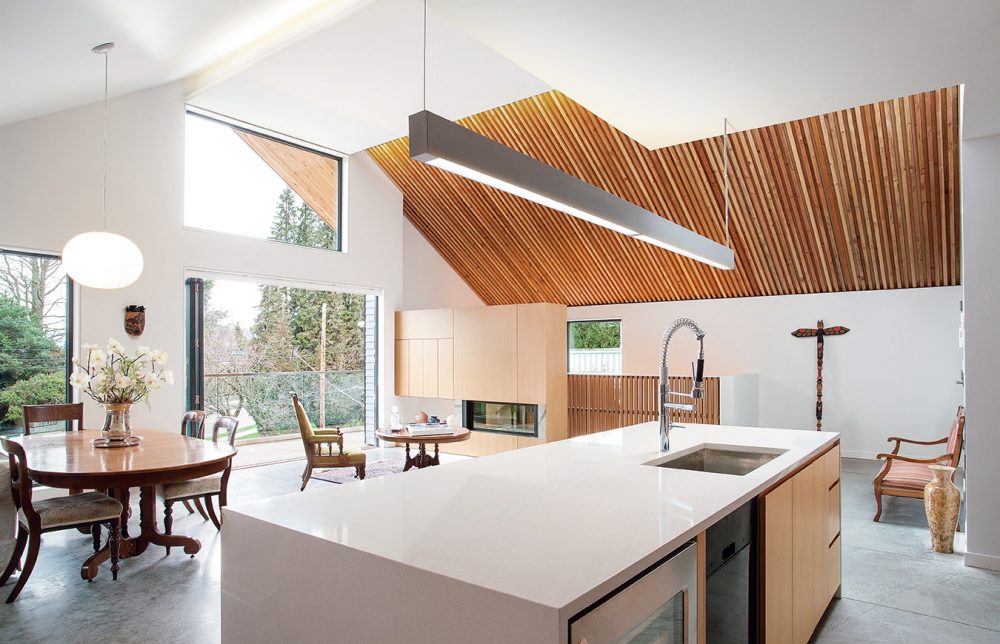Nick Sully isn’t ashamed to admit it: he’s a glass-half-full kind of guy. An optimist. A thinker. A dreamer, even. A man who sincerely and wholeheartedly believes the future can, and will, be a good deal better than the past. Not that you’d expect anything less from an architect. As Sully makes clear, ever since he was a young boy with a sketchbook he’s been interested in envisioning something better—a better building, a better community, a better city, a better future.
Currently Sully plies his trade at Shape Architecture, the firm he founded six years ago. Since then, he and his team have made a name for themselves with a number of high-visibility civic projects around the province: the Pender Harbour Aquatic Centre on the Sunshine Coast; the Fairview heritage townsite in Oliver; the West Vancouver Memorial Library. The feather in their cap: a commission to design the new integrated facility for Landscape Architecture, Architecture and Planning at the University of British Columbia. You know you’ve made it when your alma mater asks you to redesign the school at which you learned your trade.
Sully’s current project, however, is a good deal more personal than any of these: an up/down “multigenerational” duplex (mom and dad on the upper floor; adult son and wife on the lower) located about a block and a half from the beach in Vancouver’s picturesque Kitsilano neighbourhood. It’s a fair size as these things go—just over 5,000 square feet, more than enough room for some big ideas. “One of the things that excites us—one of the reasons we get up in the morning—is we realize there’s a lot of stuff that hasn’t been thought of yet,” Sully says. “There are always new hit songs that keep coming on the radio. And you think: ‘I thought that had been done already.’ But every day there’s a new song. It’s like that with architecture.”
As Sully explains, the Kitsilano project presents an intriguing architectural challenge: how to design a home that operates on both a small and a large scale; a home that addresses the needs of an individual family and the needs of a larger community at the same time. “The opportunity with individual residential design is to always think about how the home is impacting the larger city,” Sully says. “There’s a narrative—a poetic. If you scale it up, there’s a way of transforming cities.”
From the outside, Sully admits the goal is not so much transformation as it is integration. The project’s A-frame roof fits in nicely with the craftsman character of the neighbourhood. There are plenty of attractive touches: privacy screens made from long strips of edge-grain cedar; floor-to-ceiling folding doors that lead to spacious decks; a well-manicured garden that integrates seamlessly with the overall design. All told, it is a stylish, contemporary take on a well-defined form.
Open the front door, however, and you realize that as far as Sully is concerned, this house is more than a project. More accurate to call it a manifesto: a demonstration of his firm’s aesthetic prowess; a showcase for important ideas about demography, sustainability, community; a bold, uncompromising declaration of Sully’s belief in the power of well-considered space to be something more than just space. “We try to design for the senses: for the eyes, the nose, the ears, the touch,” Sully says. Instead of treating the house as an object that exists in space, Shape approaches it as an experience—a sensation the owner wants to savour over and over again. “It’s a very subjective view for us. I try to imagine what it feels like to stand in the space, rather than what it looks like to be above it looking at it in a plan.”
Space is one thing there is plenty of. Both suites offer immense, open-concept layouts. High ceilings draw the eye upward, emphasizing the feeling of openness. Large cantilevered decks extend the living area while blurring the boundary between inside and outside. Long, galley-style kitchens maximize floorspace while providing plenty of countertop real estate.
But Sully’s ideas go far beyond square footage. From the start, his team’s intention was to use a combination of innovative materials, forward-looking design and cutting-edge engineering to create a building so attractive, so livable, you don’t even notice how “green” it actually is. “Sustainability or highly efficient design should be something that people want,” Sully says. “Green design should be kind of sexy. It shouldn’t be: ‘drag me to the table to do the right thing.’ People don’t operate that way.”
Take the roof: to most, a purely functional element; to Sully, an opportunity to push the sustainability envelope. Instead of a collection of the usual collection of trusses and joists, Sully and his team designed an exposed wood plate roof system fabricated from a series of alternating 2×6 and 2×8 locally sourced dimensional lumber that offer exceptional structural support. Instead of enclosing the ceiling in environmentally unfriendly drywall, Sully decided to leave the naked wood visible from the inside: in essence, green engineering becomes art. “What you’re seeing on the ceiling is actually the structure,” Sully notes. “You can look at it, you can smell it, you can see it. You’re kind of living in it.”
Natural light is another design feature that serves as both form and function. Large windows, floor-to-ceiling doors, and skylights channel light through both sides of the duplex. In the lower suite, the stairwell itself functions as a “light tunnel” that floods the main floor in sunlight. Such ideas are not only good for the planet, they make solid economic sense: with so much natural light, the only reason to turn on the lights is when the sun goes down.
The house had begun to take its final form a month away from completion. Still, Sully remained focused squarely on the task ahead: the deadlines, the challenges, and ultimately, the solutions. “That’s our job right now, is to pick out all the things that aren’t working,” he jokes. “It feels good, though,” he adds quietly. “I feel good in this space.” Sully looks up at the ceiling and ponders his team’s work for a moment. “This is a culmination of 15 houses for us,” he reflects. “And with each one of them I think we learned from the one we just did before.” And with each one of them, the glass gets a little more full. Now that the house is alive and living, its inhabitants would agree.
Photos: Eric Scott.










